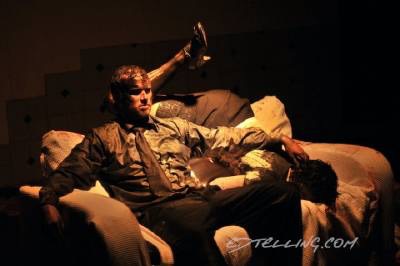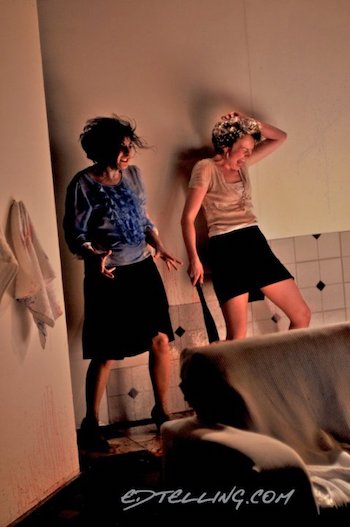A post about ‘Dash Dash Dash’, a series of shows I wrote and directed in 2010
The eight month Dash Dash Dash project is largely over. I say ‘largely’ in order to acknowledge the distressing impact of a theft which led to the abrupt cancellation of our final show. On the night of Saturday 15th May, one hour before we were to open the third night of The Omnibus (six short shows smoothed into one long one) to a full house at Battersea Arts Centre, the laptop containing our 60 cue soundtrack was stolen from the control booth of the theatre. Other than humming the various pieces of music at appropriate points there was no way we could proceed. I won’t dwell on it, it’s too depressing. We hope to regroup and re-present later in the year. (This did not happen. Ed. (2019))
There is, however, much to be pleased with. The project was premised on my writing and directing a 25 minute show once a month for six months. The shows had no narrative connection to each other but a number of shared themes bound them into an inter-related collection. I was not producing episodes in a serial but elements that, when combined, would display unobtrusive affinities and be more than the sum of their parts.

I was also keen to avoid story-telling and the presentation of fictional characters. Certainly the figures who ended up on stage were different from each other but not by dint of personality traits that would invariably be reflected in their speech and behaviour. They were physically reliable insofar as they didn’t change shape in the course of a scene (something they might have achieved in an animated film) but other than that their periods of consistency were shortlived, like particles forming then disappearing in a cloud chamber. They were not, however, vehicles for random utterance. That’s too easy.
While there are plenty of diagnostic justifications available for formless babbling – madness, brain damage, attention deficit hyperactivity disorder, post traumatic stress disorder, too much crystal meth and so forth – the use of such speech in performance has a very short shelf-life and tests its audience unnecessarily. The Surrealists, for example, tired quite quickly of the pure products of automatic writing and sought ways to tweak the recipe in order to generate a higher strike rate, while those writers taken with the cutup technique (Tzara in the 1920s, Gysin then Burroughs in the late 50s and early 60s) were in the habit, from the start, of winnowing out the nonpoetic dross from the serendipitous gemlines in simple recognition of an inevitable mathematical deadness that would otherwise reliably extinguish the spirit of the whole experiment.
Nevertheless, in one of the short shows (Show 3: ‘The Fastness’), I wanted a scene in which the figures on stage would be seized with a babbling mania of an intensity that defied all logic and continuity.
DAN Hello everybody I’ve succeeded in painting the town red in a very direct and lively manner.
ANN I disagree. It is time for unrelenting and pitiless war.
TOD Who’d like a delicious cuppa? I would. Thank you.
PAT This afternoon I’m going to strip the 444 down and see if we can’t get it to run about a bit.
DAN You could take it down the town. Which is so colourful.
ANN Yes. I’ve got people coming in from all over roundabout these parts in effect.
TOD Which is a monster plus. By Jiminy.
PAT By crikey.
ANN By fuck.
DAN Hoorah to all that.
PAT Right then! Let’s!
I wrote about 40 lines in this manner. While there is certainly a baton being passed at times, for much of the episode the lights are just popping on and off all over the neighbourhood. In order to make the scene work at all the actors had to invest it with enormous and cartoonish manic energy, simply to elevate the material from a condition of disposable random to one in which it could be said that the figures are, at least, sharing a disconcerting and uncontrollable impulsion. On a number of occasions I considered cutting the scene altogether but my gifted and indefatigable actors proved able to pull it out of the bag on a nightly basis.
I was also keen to avoid story-telling and the presentation of fictional characters. Certainly the figures who ended up on stage were different from each other but not by dint of personality traits that would invariably be reflected in their speech and behaviour. They were physically reliable insofar as they didn’t change shape in the course of a scene (something they might have achieved in an animated film) but other than that their periods of consistency were shortlived, like particles forming then disappearing in a cloud chamber. They were not, however, vehicles for random utterance. That’s too easy.
While there are plenty of diagnostic justifications available for formless babbling – madness, brain damage, attention deficit hyperactivity disorder, post traumatic stress disorder, too much crystal meth and so forth – the use of such speech in performance has a very short shelf-life and tests its audience unnecessarily. The Surrealists, for example, tired quite quickly of the pure products of automatic writing and sought ways to tweak the recipe in order to generate a higher strike rate, while those writers taken with the cutup technique (Tzara in the 1920s, Gysin then Burroughs in the late 50s and early 60s) were in the habit, from the start, of winnowing out the nonpoetic dross from the serendipitous gemlines in simple recognition of an inevitable mathematical deadness that would otherwise reliably extinguish the spirit of the whole experiment.
Nevertheless, in one of the short shows (Show 3: ‘The Fastness’), I wanted a scene in which the figures on stage would be seized with a babbling mania of an intensity that defied all logic and continuity.
DAN Hello everybody I’ve succeeded in painting the town red in a very direct and lively manner.
ANN I disagree. It is time for unrelenting and pitiless war.
TOD Who’d like a delicious cuppa? I would. Thank you.
PAT This afternoon I’m going to strip the 444 down and see if we can’t get it to run about a bit.
DAN You could take it down the town. Which is so colourful.
ANN Yes. I’ve got people coming in from all over roundabout these parts in effect.
TOD Which is a monster plus. By Jiminy.
PAT By crikey.
ANN By fuck.
DAN Hoorah to all that.
PAT Right then! Let’s!
I wrote about 40 lines in this manner. While there is certainly a baton being passed at times, for much of the episode the lights are just popping on and off all over the neighbourhood. In order to make the scene work at all the actors had to invest it with enormous and cartoonish manic energy, simply to elevate the material from a condition of disposable random to one in which it could be said that the figures are, at least, sharing a disconcerting and uncontrollable impulsion. On a number of occasions I considered cutting the scene altogether but my gifted and indefatigable actors proved able to pull it out of the bag on a nightly basis.

Pure random utterance has no spirit. On the other hand, the delicacies of the well-written and psychologically substantial character did not interest me. Inconsistent character had to be deployed in such a way that it would act as evidence of a socially pervasive inner disconnection.
DEAN Nina is an interior decorator.
ROY How’s it going?
NINA It’s tremendous.
ROY It must be very satisfying to have an interior.
NINA Are you not of fixed abode, Roy?
ROY I find them labour intensive.
(Show 6: ‘Gush’)
What I hoped to produce, across the whole of Dash Dash Dash, was the speech of figures whose insides had melted. This would not be evidence of the personal psychiatric condition of unfortunate individuals so much as a concentration of responses to an extreme and widely distributed social fragmentation.
09.06.2010
photos from ‘Gush’ by Ed Telling
to be continued…

